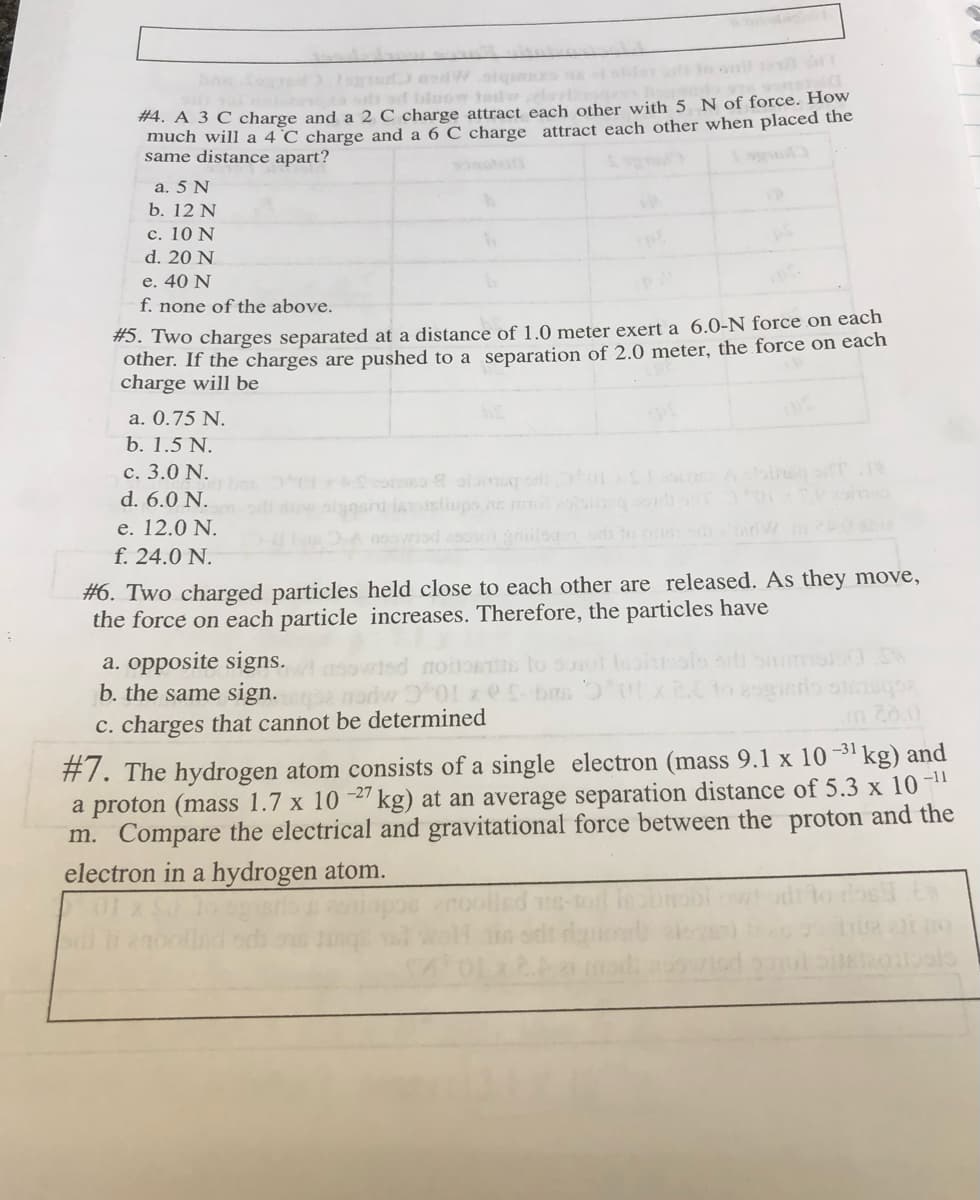#4. A 3 C charge and a 2 C charge attract each other with 5 N of force. How much will a 4 C charge and a 6 C charge attract each other when placed the same distance apart? bloow tad r a. 5 N b. 12 N c. 10 N d. 20 N e. 40 N f. none of the above.
#4. A 3 C charge and a 2 C charge attract each other with 5 N of force. How much will a 4 C charge and a 6 C charge attract each other when placed the same distance apart? bloow tad r a. 5 N b. 12 N c. 10 N d. 20 N e. 40 N f. none of the above.
College Physics
1st Edition
ISBN:9781938168000
Author:Paul Peter Urone, Roger Hinrichs
Publisher:Paul Peter Urone, Roger Hinrichs
Chapter18: Electric Charge And Electric Field
Section: Chapter Questions
Problem 10CQ: Using Figure 18.43, explain, in terms of Coulomb's law, why a polar molecule (such as in Figure...
Related questions
Question
help please with these questions

Transcribed Image Text:Ibloow tedrdo
#4. A 3 C charge and a 2 C charge attract each other with 5 N of force. How
much will a 4 °C charge and a 6 C charge attract each other when placed the
same distance apart?
a. 5 N
b. 12 N
с. 10 N
d. 20 N
e. 40 N
f. none of the above.
#5. Two charges separated at a distance of 1.0 meter exert a 6.0-N force on each
other. If the charges are pushed to a separation of 2.0 meter, the force on each
charge will be
a. 0.75 N.
b. 1.5 N.
c. 3.0 N.
d. 6.0 N.
e. 12.0 N.
Astiups ne
ds to o d W
f. 24.0 N.
#6. Two charged particles held close to each other are released. As they move,
the force on each particle increases. Therefore, the particles have
a. opposite signs.
b. the same sign.
C. charges that cannot be determined
-31 kg) and
#7. The hydrogen atom consists of a single electron (mass 9.1 x 10
a proton (mass 1.7 x 10 2" kg) at an average separation distance of 5.3 x 10-"
m. Compare the electrical and gravitational force between the proton and the
-27
electron in a hydrogen atom.
Expert Solution
This question has been solved!
Explore an expertly crafted, step-by-step solution for a thorough understanding of key concepts.
Step by step
Solved in 2 steps

Knowledge Booster
Learn more about
Need a deep-dive on the concept behind this application? Look no further. Learn more about this topic, physics and related others by exploring similar questions and additional content below.Recommended textbooks for you

College Physics
Physics
ISBN:
9781938168000
Author:
Paul Peter Urone, Roger Hinrichs
Publisher:
OpenStax College


Physics for Scientists and Engineers: Foundations…
Physics
ISBN:
9781133939146
Author:
Katz, Debora M.
Publisher:
Cengage Learning

College Physics
Physics
ISBN:
9781938168000
Author:
Paul Peter Urone, Roger Hinrichs
Publisher:
OpenStax College


Physics for Scientists and Engineers: Foundations…
Physics
ISBN:
9781133939146
Author:
Katz, Debora M.
Publisher:
Cengage Learning

College Physics
Physics
ISBN:
9781285737027
Author:
Raymond A. Serway, Chris Vuille
Publisher:
Cengage Learning

College Physics
Physics
ISBN:
9781305952300
Author:
Raymond A. Serway, Chris Vuille
Publisher:
Cengage Learning

An Introduction to Physical Science
Physics
ISBN:
9781305079137
Author:
James Shipman, Jerry D. Wilson, Charles A. Higgins, Omar Torres
Publisher:
Cengage Learning